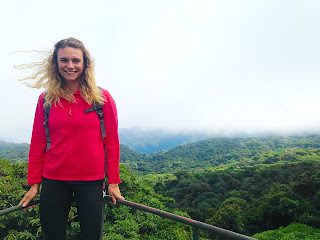After a 17 hour bus journey (yep....ONE.SEVEN for which the last two consisted of winding mountain roads with lorries swerving around each other in attempts to overtake each other like a game of cat and mouse) I finally arrived. The heavens had opened in Medellin so I took a taxi to Ivy Hostel, which is in a suburb of the main tourist area called Poblado.
I met some splendid people in the hostel that evening and five of us all booked in to do the Real City Walking tour leaving from a nearby metro station for the next morning. It was an amazing, informative tour lasting about four hours. Our tour guide Mari was hilarious, had some really interesting stories and was very knowledgeable about everywhere she took us. From the courts of justice and government buildings, to the local markets selling everything from religious calendars to hardcore porn DVDs (sometimes being sold from the same stall)! She showed us where we could buy traditional Paisa food (paisas is the name given to the people born around the Medellin area). We tried some sickly sweet 'Guarape', similar to lemonade, Empanadas (corn dough, deep fried filled with meat), coffee and arepas (corn dough, grilled and stuffed with cheese). We learnt about the turbulent and violent history of Medellin, mostly brought about by the infamous Pablo Escobar. Obviously as a result of the terror he brought to the city, he is not popular with many of the locals. We learnt about the corrupt right and left wing groups and the previous governments. We visited a church where we saw a few 'working girls' hanging around outside. Prostitution is legal in Medellin and Mari explained to us that the local men would come to 'visit' these ladies and after attend church for confession to cleanse their sole again. Bizarre! really recommend the tour, even though it is classed as 'free', the guides earn their money from tips at the end.
The church and the prostitutes
 |
| Our tour guide getting some help from a local man |
That afternoon we went to the Cable cars of San Domingo, you pay using your metro card and can go further up for another couple of dollars. We paid the extra and it was worth it. Before long we were out of the crowded neighbourhoods of Medellin and were zipping over dense forest. On the way back down we got out and ended up stumbling through a local neighbourhood. It was very local and everyone was so friendly. We had some great, basic street food and 'tinto' (coffee), sometimes with copious amounts of sugar in! For about $2 altogether. We sat on the side of the street and ate the chorizo and chips before heading back down in the cable cars.
 |
| Overlooking Communa 13 |
 |
| Street murals of Communa 13 |
 |
| Arenas with cheese in the market |
The next morning I went to 'the most colourful town in Latin America' called Guatapé worn a girl called Helen I met in Medellin (after the night out everyone else felt too fragile to venture out). We took the metro to the bus terminal and an hour and a half bus to Guatapé costing $4. We got off the 'El Peñón de Guatapé or The rock. The bus dropped us at the end of some stairs....we thought it was the beginning of the 740 steps up the top. Only after ten minutes of walking up the stopes in the heat did we realise we hadn't even made it to the entrance. I was really struggling and was thinking if I had known Helen a bit better I would have tapped out there, curled into the foetal position and cried. However we kept going..and I'm so glad we did. The view at the top of the rock was breathtaking. We took a tuk tuk into Gutapé town and had a wander around enjoying the buzz of Colombian tourists visiting for the weekend. We got some BBQ'd corn and ice cream and weaved through the colourful streets.
 |
| The rock, 740 steps up |
 |
| Worthwhile view |
 |
| Colourful Guatpé |
The next day was my last in Medellin. I went to Minorista market, a local food market but it also sold anything else you could imagine. I spent the rest of the day wandering around Medellin with Helen, sampling some great coffee, arepas with cheese and enjoying the buzz of the city. Unfortunately later that night I took an overnight bus to Bogota where I would be reunited with Kirsty and we were flying to Ecuador together.
Next Stop: Quito, Ecuador.
Food/Drink: Arepas with cheese, cooked in the hostel. Aguardiente liquor and Medellin rum.
Bars/Restaurants: went out in Poblado. Ate in Minorista market and street food in Guatapé
Stayed: Ivy house hostel, such a great comfortable and social hostel for about $10 per night including a great breakfast.

































